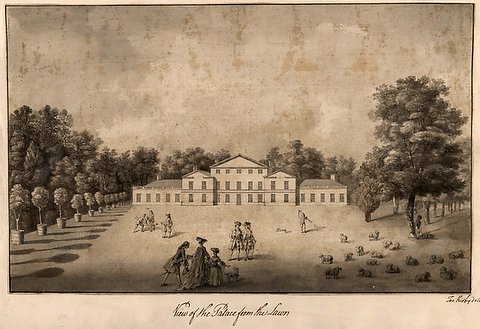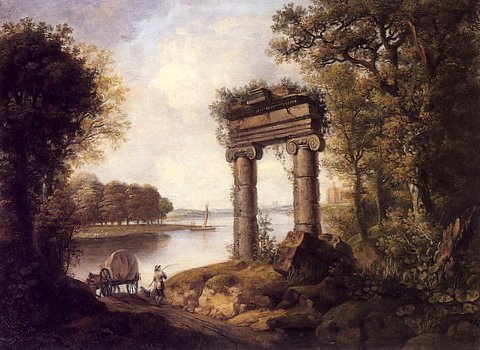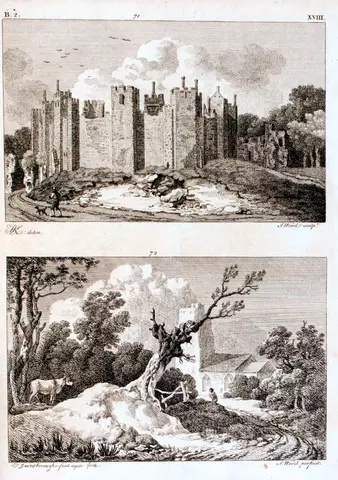KIRBY, Joshua
Joshua Kirby was born at Parham, Suffolk in 1716, second of the eleven children of John Kirby (1690-1753), schoolmaster and surveyor, and his wife Alice née Brown (1685/6–1766). Joshua was educated at his home at Wickham Market, Suffolk and assisted his father in his book, 'The Suffolk Traveller' (1735) and a map of Suffolk (1736). In 1739 Joshua married Sarah Bull (c.1718–1775), daughter of Abraham Bull of Framlingham and they lived at Ipswich, where Joshua had already joined in a house and coach-painting business, in which one of his apprentices was James Dunthorne. In 1744 Kirby was commissioned to design an altarpiece for St Mary's Church, Hadleigh, Suffolk and in June 1748 published his twelve prints of Monasteries, Castles &c., the prints had been engraved in London by Joseph Wood (1720-1763/4), and subscribers were given gratis, a pamphlet 'An Historical Account of the Twelve Prints of Monasteries, Castles, Antient Churches and Monuments, in Suffolk', there was an extremely rare 13th print. Kirby's experience enabled him to assist his new friend artist Thomas Gainsborough with the painting of St Mary's, Hadleigh and in 1751 Kirby was in London with William Hogarth (1697-1764) and that spring he advertised in the 'Ipswich Journal' the sale of Hogarth's prints and invited subscriptions for his own book 'Dr Brook Taylor's Method of Perspective Made Easy' that was published in February 1754 and dedicated to Hogarth, who contributed the comic frontispiece. In January 1754, the Académie Royale de Peinture et de Sculpture (Royal Academy of Painting and Sculpture) had approved Kirby's three lectures on perspective as well as his book and elected him a member. Reprinted three times (1755-1768), with additions, the book became the standard exposition of perspective for British artists until superseded by Thomas Malton's 'Treatise' in 1775. Hogarth stood firm with Kirby on disputed points, an association which led to Kirby being featured in two of Paul Sandby's (1731-1809) satirical prints on Hogarth's 'Analysis of Beauty' in 1754. Through the good offices of the Earl of Bute, Kirby became teacher of perspective and fortifications to the Prince of Wales in 1756 and, leaving his Ipswich business in the hands of Andrew Baldry (1728-1802), together with his family moved to Great Queen Street, London with Baldry acquiring the Ipswich business in 1759 when Kirby moved to Kew Green, Richmond, Surrey. In 1761 Kirby published the handsome 'Perspective of Architecture deduced from the Principles of Dr. Brook Taylor' which included as plate 44 'House with a Colonnade' by the prince, who was involved with the publication and paid for the many of the illustrations. On his accession as George III in 1761, the king rewarded Kirby and his son William Kirby (1743–1771), appointing them joint clerk of the works at Kew and Richmond this post was not sinecure and young William, a promising artist, went, at the king's expense, with his wife to study architecture in Italy 1768–1769. On their return William Kirby was given a house at Kew, where he died in 1771. In 1767 Joshua had been elected a fellow of the Royal Society and a fellow of the Society of Antiquaries. Kirby contributed three drawings to 'Gardens and Buildings at Kew' (1763) by Sir William Chambers (1723-1796), who gave Kirby many orders for works on the royal estates. Kirby was president of the Society of Artists of Great Britain 1768–1771 and from 1761 Kirby had exhibited drawings including 'St Albans Abbey' (1767) but his oils 'Kew Ferry' (1767) and 'Ockham Mill' (1769) were attributed by Horace Walpole to the king. However, King George III, with Benjamin West (1738-1820) and Chambers, planned a royal academy which was formed in December 1768. Kirby died peacefully at Kew Green on 20 June 1774, and buried in Kew chapel (now St Anne's, Kew) when the date of is death is noted as 21 June. He owned many works by Gainsborough, which appeared in the Trimmer sale, Christies, 17 March 1860, who had painted Kirby with his wife (c.1750). Such was Gainsborough's confidence in his ‘old friend pudging Josh’ that he was buried alongside him at St Anne's, Kew. He is very often incorrectly given the names of John Joshua Kirby.
Works by This Artist

|
Sandpit near Sudbury, SuffolkOil on canvas
|

|
View of the Palace from the Lawn at KewInk and wash
|

|
Classical Landscape with RuinsOil on canvas
|

|
Views of Framlingham Castle, Suffolk, and a rural landscapeEtching
|